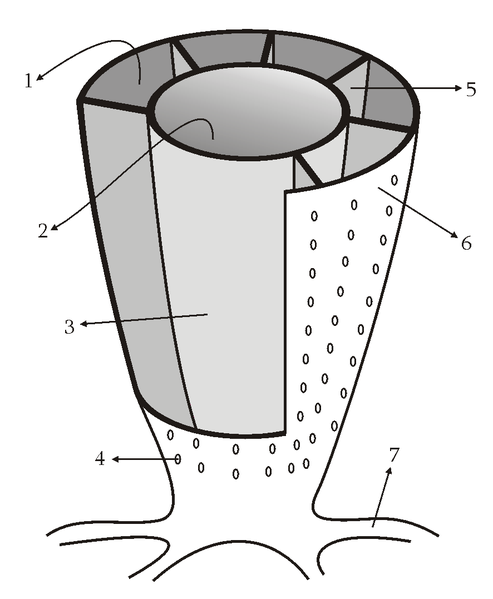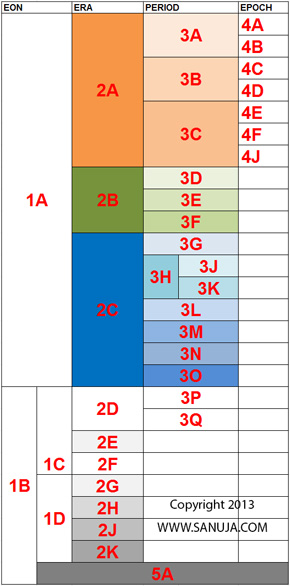Notice
This is the non-interactive basic mode of GLGY 491 questions database for printing or use in case of SQL database failure on main site. All the questions and answers are identical except the order of questions and answers.Please use the interactive version for more up to date materials.
Geology (GLGY 491-UCAL) Midterm I General
|
Question 1
|
|
Amblyprocts
|
|
|
Porocytes
|
|
|
Scierocytes
|
|
|
Archaeocytes
|
|
Question 2
|
|
Permian – Triassic
|
|
|
Devonian – Silurian
|
|
|
Devonian – Carboniferous
|
|
|
Carboniferous – Permian
|
|
|
Cretaceous – Paleogene
|
|
Question 3
|
|
Pentameral
|
|
|
Radial
|
|
|
Spherical
|
|
|
Circular
|
|
Question 4
|

Image Source: http://en.wikipedia.org/wiki/File:Archaeocyatha.png
|
7
|
|
|
1
|
|
|
5
|
|
|
2
|
|
Question 5
|
|
Devonian
|
|
|
Mississippian
|
|
|
Triassic
|
|
|
Jurassic
|
|
Question 6
|
|
False
|
|
|
True
|
|
Question 7
|
|
False
|
|
|
True
|
|
Question 8
|
|
541 Ma
|
|
|
4030 Ma
|
|
|
4560 Ma
|
|
|
2500 Ma
|
|
Question 9
|
|
True
|
|
|
False
|
|
Question 10
|
|
Canonization
|
|
|
Impregnation
|
|
|
Recrystallization
|
|
|
Moldic fossilization
|
|
Question 11
|
|
The trace fossils left by the organism during certain growth periods.
|
|
|
Abundance in organic matter in some parts of the stratigraphic windows.
|
|
|
The lack of exoskeletons in some parts of the stratigraphic windows.
|
|
|
Fossils of the organism were found without the exoskeleton.
Hint:
Impossible due to soft body dissolution.
|
|
Question 12
|
|
I. Permian
II. Neogene |
|
|
I. Permian
II. Devonian |
|
Question 13
|
|
True
|
|
|
False
|
|
Question 14
|
|
Ascon
|
|
|
Hyperdemia
|
|
|
Leucon
|
|
|
Rhagon
|
|
|
Sycon
|
|
Question 15
|
|
three
|
|
|
four
|
|
|
five
|
|
|
two
|
|
Question 16
|
|
False
|
|
|
True
|
|
Question 17
|
|
Suborder
|
|
|
Subtribe
|
|
|
Subspecies
|
|
|
Tribe
|
|
|
Subfamily
|
|
Question 18
|
|
Nongenetic Trajectory
|
|
|
Genetic Trajectory
|
|
|
Morphological Trajectory
|
|
|
Ontogeneric Trajectory
|
|
Question 19
|
|
PTD
|
|
|
LAD
|
|
|
Acme Zone
|
|
|
Evolutionary Occurrence
|
|
Question 20
|
|
amblyproct
|
|
|
euryproct
|
|
|
stenoproct
|
|
|
platyproct
|
|
Question 21
|
|
Morphological
|
|
|
Stratigraphic
|
|
|
Chemical
|
|
|
Genetic
|
|
Question 22
|
|
Impregnation
|
|
|
Carbonization
|
|
|
Impressions
|
|
|
Congealment
|
|
Question 23
|
|
False
|
|
|
True
|
|
Question 24
|
|
Superclass
|
|
|
Order
|
|
|
Phylum
|
|
|
Kingdom
|
|
Question 25
|
|
True
|
|
|
False
|
|
Question 26
|
|
66 millions of years ago
|
|
|
13 millions of years ago
|
|
|
541 millions of years ago
|
|
|
0.0117 millions of years ago
|
|
Question 27
|
Choose the odd one out based on the process of fossilization. (Choose the best option!)
Insects
Diatoms
Bivalves
Coccolithophorids
Sponges
Gastropods
|
Gastropods
|
|
|
Diatoms
|
|
|
Bivalves
|
|
|
Insects
|
|
Question 28
|
|
biostratigraphy.
|
|
|
taxa.
|
|
|
taxonomy.
|
|
|
evolutionary biology.
|
|
Question 29
|
|
252.17 Ma
|
|
|
0.011710 Ma
|
|
|
541 Ma
|
|
|
66.0 Ma
|
|
Question 30
|
|
Class and Species
|
|
|
Genus and Species
|
|
|
Phylum and Family
|
|
|
Order and Family
|
|
Question 31
|
|
humans.
|
|
|
trilobite.
|
|
|
bivalves.
|
|
|
echinoids.
|
|
Question 32
|
|
Morphological Zones
|
|
|
Assemblage Zones
|
|
|
Interval Zones
|
|
|
Acme Zones
|
|
Question 33
|
|
I. non-symmetrical
II. symmetrical |
|
|
I. anisometric
II. isometric |
|
|
I. isometric
II. anisometric |
|
|
I. symmetrical
II. non-symmetrical |
|
Question 34
|
|
Permian
|
|
|
Archean
|
|
|
Silurian
|
|
|
Devonian
|
|
Question 35
|
|
Class Germaphobia
|
|
|
Class Hexactinellida
|
|
|
Class Calcarea
|
|
|
Class Demospongea
|
|
Question 36
|
|
False
|
|
|
True
|
|
Question 37
|
|
Early Lower Permian
|
|
|
Middle Ordovician
|
|
|
Lower Silurian
|
|
|
Early middle Cambrian
|
|
Question 38
|
|
Archaeocyathid
|
|
|
Lingula
|
|
|
Inoceramus
|
|
|
Pentremites
|
|
Question 39
|
|
dinosaurs.
|
|
|
insects.
|
|
|
coprolites (poops).
|
|
|
mammals.
|
|
Question 40
|
|
Chemical compositional studies
|
|
|
Morphological studies
|
|
|
Genetic studies
|
|
|
Behavioral studies (trace fossils)
|
|
Question 41
|
|
Phylum Helmichordata
|
|
|
Phylum Porifera
|
|
|
Phylum Cnidaria
|
|
|
Phylum Brachiopoda
|
|
Question 42
|
|
Echinoids great are examples discontinuous genetic variability.
|
|
|
Continuous genetic variability occurs in species with large morphological differences between sexes.
|
|
|
Discontinuous genetic variability is more frequent than continuous genetic variability.
|
|
|
Discontinuous genetic variability is less frequent than continuous genetic variability.
|
|
Question 43
|
|
ecologic.
|
|
|
biocherms.
|
|
|
reefs.
|
|
|
platonic.
|
|
Question 44
|
|
False
|
|
|
True
|
|
Question 45
|
|
Hexagonaria
|
|
|
Cnidaria
|
|
|
Cristata
|
|
|
Animalia
|
|
Question 46
|
|
classes
|
|
|
orders
|
|
|
families
|
|
|
phyla
|
|
|
genera
|
|
Question 47
|
|
Abundance of specific organisms in a given time window.
|
|
|
The last appearance of an organism/group.
|
|
|
Sudden fluctuation in morphological features of an organism/group.
|
|
|
The first appearance of an organism/group.
|
|
Question 48
|
There are only two sub-Periods (subdivisions) on this diagram. They are represented by 3J and 3K. What are they?
Note: DO NOT scroll down to the Geologic Time scale on this page. Answer this without using any AIDS.
|
3J – Mississippian
3K – Pennsylvanian |
|
|
3J – Pennsylvanian
3K – Mississippian |
|
|
3J – Silurian
3K – Devonian |
|
|
3J – Devonian
3K – Silurian |
|
Question 49
|
|
Set of organisms with similar physical characteristics.
|
|
|
Populations that naturally breed together and provide viable offspring.
|
|
|
Grouping of kingdoms which have the height precedence in taxonomy.
|
|
|
Diagnosable cluster within which there is a pattern of ancestry.
|
|
Question 50
|
|
6000 years
|
|
|
50,000 years
|
|
|
8,000 years
|
|
|
22,000 years
|
|
|
11,700 years
|
|
Question 51
|
This particular Period is known for high volumes of coal formations. It is first appears on Geological records around 358.9 Ma. What is the Period and it’s location on the following diagram?
Note: DO NOT scroll down to the Geologic Time scale on this page. Answer this without using any AIDS.
|
Carboniferous; 3H
|
|
|
Jurassic; 3D
|
|
|
Carboniferous; 3B
|
|
|
Jurassic; 3E
|
|
Question 52
|

|
Radial
|
|
|
Pentameral
|
|
|
Not enough information is given.
|
|
|
Bilateral
|
|
Question 53
|

|
Cruziana
|
|
|
Brachiopod
|
|
|
Ammonite
|
|
|
Trilobite
|
|
Question 54
|
|
index fossils
|
|
|
most abundant fossils
|
|
|
trace fossils
|
|
|
identity fossil
|
|
|
characteristic fossil
|
|
Question 55
|
|
True
|
|
|
False
|
|
Question 56
|
|
Cretaceous to Neogene
|
|
|
Cambrian to Mississippian
|
|
|
Ordovician-Devonian
|
|
|
Ordovician to Permian
|
|
Question 57
|
|
They have well specialized organs.
|
|
|
They are planktonic organisms.
|
|
|
They lived attached to the substratum with the aid of root-like structures.
|
|
|
SpongeBob SquarePants can NOT be classified into Phylum Proifera.
|
|
Question 58
|
|
living environments
|
|
|
genetic structures
|
|
|
genetic variation
|
|
|
growth stages.
|
|
Question 59
|
|
Modification
|
|
|
Molting
|
|
|
Addition
|
|
|
Accretion
|
|
Question 60
|
What are the Eons represented by 1A and 1B respectively on the following diagram?
Note: DO NOT scroll down to the Geologic Time scale on this page. Answer this without using any AIDS.
|
Cenozoic and Mesozoic
|
|
|
Cenozoic and Paleozoic
|
|
|
Phanerozoic and Precambrian
|
|
|
Proterozoic and Archean
|
|
Question 61
|
|
True
|
|
|
False
|
|
Question 62
|
|
archaeocytes
|
|
|
choanocytes
|
|
|
sclerocytes
|
|
|
pinacocytes
|
|
Question 63
|
|
Biradial symmetry
|
|
|
Radial symmetry
|
|
|
Spherical symmetry
|
|
|
Bilateral symmetry
|
|
Question 64
|
-underwent rapid burial
-internal structures were often preserved
-most fossils from Ediacaran period were fossilized through this process.
|
Carbonization
|
|
|
Permineralization
|
|
|
Permineralization
|
|
|
Impressions
|
|
Question 65
|
|
True
|
|
|
False
|
|
Question 66
|
|
Paleozoic
|
|
|
Carboniferous
|
|
|
Cenozoic
|
|
|
Mesozoic
|
|
|
Precambrian
|
|
Question 67
|
|
True
|
|
|
False
|
|
Question 68
|
– the frustule is composed of organic silica
– radial symmetry
– found in sediment samples throughout Jurassic to Holocene
– is a microfossil
This sample most like be a…
|
slilicoflagellate.
|
|
|
tasmanitid.
|
|
|
coccolithophorid.
|
|
|
diatom.
|
|
|
not enough data to distinguish.
|
|
Question 69
|
|
old.
|
|
|
young.
|
|
|
under development.
|
|
|
mature.
|
|
Question 70
|
|
ecological conditions.
|
|
|
differentiation between growth stages.
|
|
|
sexual dimorphism.
|
|
|
sudden changes in genetic variation.
|
|
Question 71
|

Image Source: http://en.wikipedia.org/wiki/File:Archaeocyatha.png
|
holdfast
|
|
|
basal ring
|
|
|
feet
|
|
|
central cavity
|
|
Question 72
|
|
two
|
|
|
one
|
|
|
infinite
|
|
|
three
|
|
Question 73
|
|
True
|
|
|
False
|
|
Question 74
|
On the following diagram, what is highlighted in 2D?
Note: DO NOT scroll down to the Geologic Time scale on this page. Answer this without using any AIDS.
|
Devonian
|
|
|
Ediacaran
|
|
|
Cretaceous
|
|
|
Ordovician
|
|
|
Neoproterozoic
|
|
Question 75
|
|
Modification
|
|
|
Addition
|
|
|
Accretion
|
|
|
Molting
|
|
Question 76
|
What is 3L on the following diagram?
Note: DO NOT scroll down to the Geologic Time scale on this page. Answer this without using any AIDS.
|
Devonian
|
|
|
Pennsylvanian
|
|
|
Ordovician
|
|
|
Jurassic
|
|
Question 77
|
|
Original Linnaean hierarchy
|
|
|
Modern Linnaean hierarchy
|
|
|
Improved Linnaean hierarchy
|
|
Question 78
|
|
cells
|
|
|
test
|
|
|
opaline silica
|
|
|
frustule
|
|
Question 79
|
|
Cretaceous
|
|
|
Eoarchean
|
|
|
Ediacaran
|
|
|
Holocene
|
|
Question 80
|
|
Archaeocytes
|
|
|
Choanocytes
|
|
|
Sclerocytes
|
|
|
Pinacocytes
|
|
Question 81
|
On the following diagram, what is highlighted in 3C?
Note: DO NOT scroll down to the Geologic Time scale on this page. Answer this without using any AIDS.
|
Paleogene
|
|
|
Cretaceous
|
|
|
Permian
|
|
|
Quaternary
|
|
Question 82
|
|
Quaternary
Hint:
This is the period and NOT the era.
|
|
|
Miocence
|
|
|
Cenozoic
|
|
|
Holocene
Hint:
This is the Epoch and NOT the era.
|
|
Question 83
|
|
Fossilization in Amber
|
|
|
Impregnation
|
|
|
Congealment
|
|
|
Moldic fossilization
|
|
Question 84
|
|
Neogene
|
|
|
Paleozoic
|
|
|
Neoproterozoic
|
|
|
Carboniferous
|
|
Question 85
|
On the following diagram, around what time 5A ended?
Note: DO NOT scroll down to the Geologic Time scale on this page. Answer this without using any AIDS.
|
4560 Ma
|
|
|
66.0 Ma
|
|
|
252.17 Ma
|
|
|
4030 Ma
|
